Sound
Katana’s sound can be easily described in a few words. Balanced with great musicality.
The entire frequency range, from top to bottom, is well extended and features excellent resolution. When you look at the driver configuration you might think that Katana probably won’t have the mightiest bass around. While Katana truly is not a bass heavy iem, it still has very satisfying low end quality. It does reach very deep, has great body and texture with outstanding depth. Sub bass is nicely defined with great clarity. Katana does have a softer going bass, so it is not as hard hitting like its 10BA siblings Encore and K10, but this gives the low ends a more enjoyable tuning.
Mids are nicely spacious and full, again with great clarity and resolution. They are very balanced, but definitely not flat, here and there are slight bumps in the curve to give air to the instruments and vocals. While at the same time they are not presented too forward, keeping the presentation in focus and not get vocals too much in front. What has stuck with me the most is the wonderful harmonics Katana sports in its mids. Everything finds its place on stage.
Katana’s treble is again well extended, with a touch of softness. Highs are very detailed, rich, crisp and clear, but they never show signs of sibiliance. There is a nice portion of body in the treble to give it a pleasing listen, making sure to not cause fatigue over time. The high extension of Katana’s treble gives it plenty of room for it to really sparkle. I never found Katana to have harsh or hot treble.
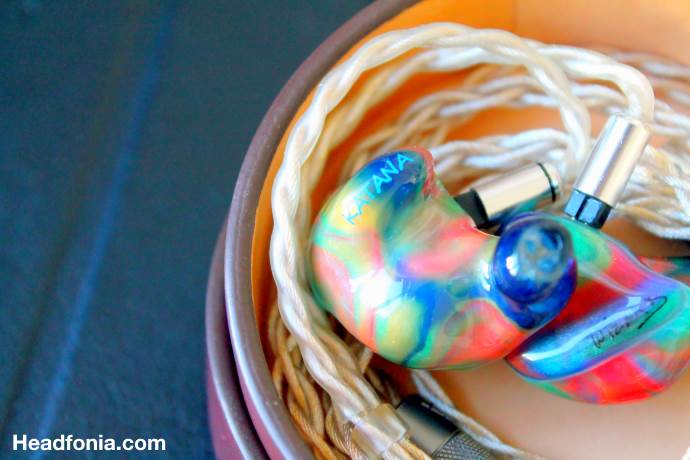
Before I listened to Katana, I was mostly after a warmer and fuller sound, but this tiny piece of a musical instrument has shown me how great a neutral tuned monitor can be. Katana shows exactly what is in the tracks. Its detail retrieval is outstanding. Pinpoint imaging is one of Katana’s key strengths. Every note, every musician gets fabulously separated making sure that all there is in the music can be easily distinguished.
Katana’s stage is one of the biggest out there and is only topped by one other monitor in my collection – 64’s A18. It reaches very deep and wide. The dimensions of its stage lean more towards width and depth than height. Katana forms a outstanding sound stage with perfect imaging and air between the instruments. Resolution and precision are two strengths where Katana outshines its competition. Speed and dynamics are remarkable. No matter what I threw at Katana it always stayed in control of everything. It never had a tendency to distort.
Due to Katana’s more neutral tuning it should be noted, that it will reveal the quality of the recordings very well and is absolutely not forgiving. If the file sucks, Katana will tell you, there is no sugarcoating at all. But on the other hand that also means, that the better the recording the better the experience with Katana will be. I have a DSD album of Beethoven’s ninth on my SP1000 which is mind-twisting with Katana. So to enjoy Katana to the absolute fullest you should make sure to have a good selection of well recorded albums on your DAP of choice.
What about sound differences between custom and universal? It all depends on your choice of tips, insertation and mostly a good fit. I found, that there are little to none differences when using Katana with foam tips that seal perfectly (just roll them like you would with Comply’s and insert into your ear, they’ll adapt fine to your nature). The universal Katana does sport a slightly bigger body with foam tips in my opinion, while the custom has a little better resolution and transparency.
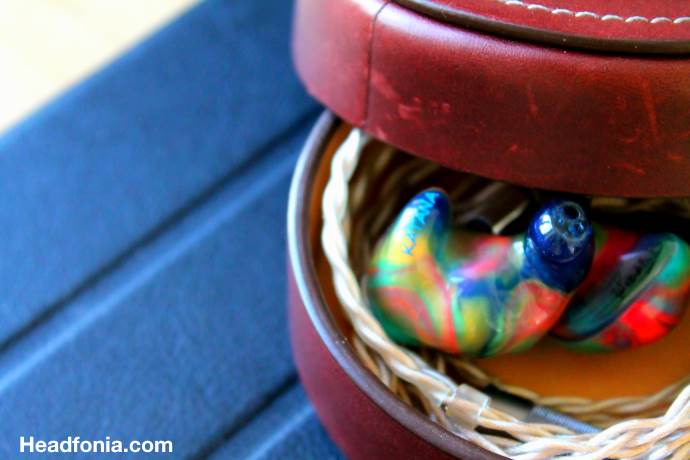
Sound tweaking
Katana is one of the few monitors that is very sensitive to change. Universal Katana for example reacts very well to small changes like tip rolling, while I always found it best with foam tips because of the enhanced body and softness. Silicone tips provide a good margin more air for the spectrum, but to me it was missing that full nice body.
But that is not the only small change with big impact on sound. Katana also provides great insight on sound of cables, I know that is still a very difficult topic around, but cable-sound was never so obvious than with Katana to me. During my review time I had the opportunity to try Katana with a number of different cables by three manufacturers. Effect Audio, PlusSound and Labkable. All used cables have their respective strengths and purposes to alter the signature in a specific way.
I recently purchased PlusSounds X-series cable with gold plated copper conductors. It added a certain punch to Katana’s lower end, gave mids a nice body while still retaining their incredible resolution. Treble was a little softened taken down as was sound stage. What I highly value the GPC X cable for is its wonderful flexibility and ergonomics, apart from sound of course.
Another PlusSound cable in my inventory is the Exo series’ T-Metal, a cable that consists of three different types of wires. Silver, gold-plated silver and gold-plated copper. A very unusual and unique mixture of conductors. The match with Katana is very nice. Detailed, airy and a great sound stage with wonderfully harmony and body all around.
Labkable’s Samurai III is a cable that much like Leonidas consists of silver and gold-plated silver, but additionally also sports some parts of platinum. It enhances the Noble’s mid body by a decent margin and gives more emotion to the whole presentation with a very nicely spread sound stage. It keeps the wonderful clarity of Katana in tact and results in a great listening experience when you need to breathe extra soul into Katana.
The eight-wire Silver Galaxy Mix II is another Labkable in my possession. The cable can be broken down to four silver-plated copper and 7N OCC copper wires each. It sports great transparency and body down low, but loses out on resolution and stage compared to other offerings.
Effect Audio’s Leonidas gave Katana a very nice additional bass and low-mid body while retaining the incredible clarity and detail up top. The sound of this combination was very harmonic, organic, spacious and detailed – definitely one of my favourites for Katana.
With cables it’s all about finding a good match for each other. I personally used the Samurai III and Leonidas cables most with Katana. Your mileage may vary.
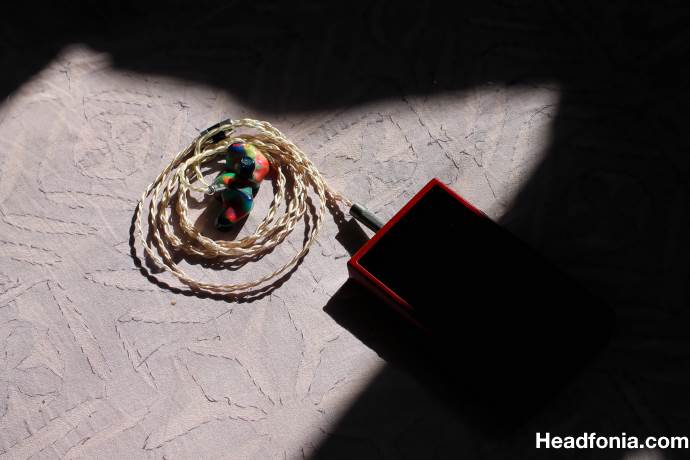
Sources
While most of my listening was done on Astell&Kern‘s newest flagship DAP, I must admit, my favourite source for Katana was something very different – the L3 Pro by Luxury&Precision.
The warmer and musical L3 Pro might not be on par with AK’s resolution or stage, but it is a damn fine sounding audio player, and definitely the best sounding in its class. It gives Katana a little more blood, body and emotion, forming a very intriguing and engaging listen. I can easily listen to this combination the entire day. Especially when paired with a nice balanced cable such as the Leonidas by Effect Audio. The balanced output of the L3 Pro is outstanding, offering incredible precision on its own. The combination of L3 Pro – Leonidas – Katana is a very addictive one and I’ve been using this setup quite a bit actually, but as stated before, the SP1000 has seen more playtime with Katana. That’s simply because it holds my favourite artists and albums and has a software that’s actually usable, unlike the one of all Luxury&Precision DAPs. If only they would update their firmware once in a while…
At the office I’ve been using Chord’s Hugo² as my main source, fed by Roon’s radio function. The Hugo is definitely an outstanding piece of gear and is well worth every penny. The sound-result of both is one of a highly resolving and natural, with incredible separation, imaging and extreme precision. The sound stage both units form together is unbelievable with splendid musicality. I’ve said it in my Hugo² review a couple of weeks back, I’d call it almost clinical, if it weren’t retaining such great musicality and warmth. One thing has to be noted though, Katana does reveal Hugo²’s background hissing. It is not disturbingly much, but it can be heard in quite passages without a doubt.
The beauty of Katana is that it shows you exactly how different sources sound, and that also gives you the possibility to tune Katana with your source easily. I personally recommend using a warmer source with Katana, as it gives it enhances its body and musicality. But of course you are free to pick your preferred DAP, DAC/Amp etc 🙂
Comparisons and Conclusion on the last page!





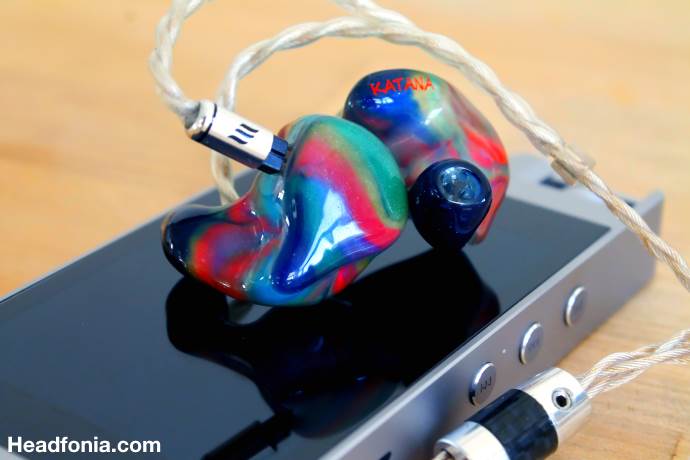
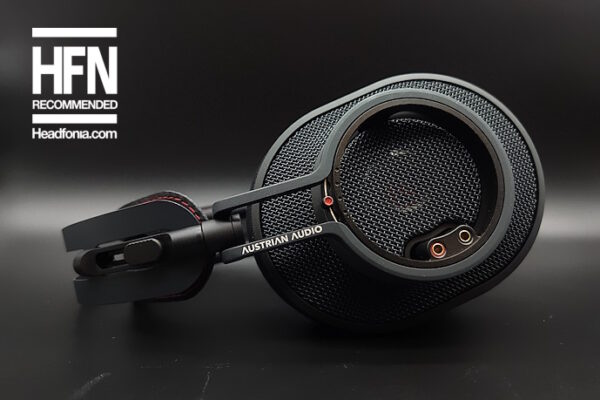

David
Hello Linus,
Could you compare 64 Audio Tia Fourte and Noble Audio Katana?
I usually listen to pop (Sam Smith, Adele, Sia, Ed Sheeran, Maroon 5, Mariah Carey…), and I am wondering which one you would recommend between two.
Also, which one would you recommend between Noble Audio Katana and JH Audio Lola? (Yes, I read that you mentioned Lola is well suited for Jazz and Rock, but how about those ones I listen to?)
Thank you 🙂
Dave
Linus
Hi Dave,
wow, how could I miss your comment? I’m so sorry. Overdue would be an understatement.
The Tia Fourté is a lot cleaner and more spacious, it has more treble energy and is more forward in that regard. Bass is more natural with more air in it. Mids are more transparent. Katana is a wonderful precision knife and a reviewers delight, as it is outstandingly true to the chain (source, cable, amp).
Lola is much darker than Katana and has more emotional mids that would suit Jazz very well, but you won’t get the precision and resolution of Katana in it.
Did you find your poison yet?
Sorry again for not responding sooner…
Hope I could help.